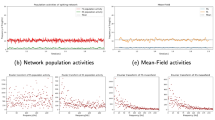Abstract
A linear spatially distributed model of a chain of neurons and interneurons was investigated in relation to the generation of propagated alpha rhythmic activity. It was assumed that the elements of the chain were interconnected by means of recurrent collaterals and inhibitory fibres in such a way that the connectivity functions were assumed to be homogeneous and their strength was an exponentially decreasing function of distance. It was found that such a neuronal chain shows propagation properties for frequencies in the alpha band. The results obtained with the model are in agreement with the phase velocities encountered experimentally. In this way, it was possible to estimate the length of the neural fibres responsible for the phenomenon of propagated activity. The estimates obtained are in good agreement with recent quantitative neuroanatomical data on the circuitry of the neocortex.
Similar content being viewed by others
Literature
Andersen, P. and S. A. Andersson. 1968.Physiological Basis of Alpha Rhythm. New York: Appleton-Century-Crofts.
Andersen, P., M. Gillow and T. Rudford. 1966. “Rhythmic Activity in a Simulated Neuronal Network.”J. Physiol., Lond.,185, 418–428.
Braitenberg, V. 1977.On the Texture of Brains. New York: Springer-Verlag.
— 1978. “Cortical Architectonics: General and Areal.” InArchitectonics of the Cerebral Cortex, Eds. M. A. B. Bazier and H. Petsche, pp. 443–465. New York: Raven Press.
Chow, K. L. and A. L. Leiman. 1970. “Aspects of the Structural and Functional Organization of the Neocortex.”Neurosc. Res. Prog. Bull.,8, No. 2, 157–183.
Katchalsky, A. K., V. Rowland and R. Blumenthal. 1974. “Dynamic patterns of brain cell assemblies.”Neurosc. Res. Prog. Bull.,12, No. 1, 1–187.
Lopes da Silva, F. H., A. Hoeks, A. Smits and L. H. Zetterberg. 1974. “Model of Brain Rhythmic Activity.”Kybernetik 15, 27–37.
—, A. van Rotterdam, P. Barts, E. van Heusden and W. Burr. 1976. “Models of Neuronal Populations. The Basic Mechanisms of Rhythmicity.” InProgress in Brain Research, Eds. D. Swaab and M. A. Corner, Vol. 45, pp. 281–308. Amsterdam: Elsevier/North Holland Biomedical Press.
— and W. Storm van Leeuwen. 1978. “The Cortical Alpha Rhythm in Dog: the Depth and Surface Profile of Phase”. InArchitectonics of the Cerebral Cortex, Eds M. A. B. Brazier and H. Petsche, pp. 319–333. New York: Raven Press.
—, J. E. Vos, J. Mooibroek and A. van Rotterdam. 1980a. “Partial Cohenrence Analysis of Thalamic and Cortical Alpha Rhythms in Dog—a Contribution Towards a General Model of the Cortical Organization of Rhythmic Activity”. InRhythmic EEG Activities and Cortical Functioning, Eds G. Pfurtscheller, P. Buser, F. H. Lopes da Silva and H. Petsche, pp. 33–59. Amsterdam: Elsevier/North Holland Biomedical Press.
—, J. E. Vos, J. Mooibroek and A. van Rotterdam. 1980b. “Relative Contributions of Intracortical and Thalamo-Cortical Processes in the Generation of Alpha Rhythms Revealed by Partical Coherence Analysis.”Electroenceph. Clin. Neurophysiol. 50, 449–456.
Nunez, P. L. 1974. “Wavelike Properties of the Alpha Rhythm.”IEEE Trans. Biomed. Eng.,BME-21, 473–481.
Scott, A. C. 1977.Neurophysics, Ch. 7. New York: Wiley.
Szentágothai, J. 1978a. “Specificity Versus (Quasi) Randomness in Cortical Connectivity”. InArchitectonics of he Cerebral Cortex. Eds. M. A. B. Brazier and H. Petsche, pp. 77–97. New York: Raven Press.
Szentágothai, J. 1978b. “The Local Neuronal Apparatus of the Cerebral Cortex”. InCerebral Correlates of Consious Experience, Inserm Symp. no. 6, Eds. P. Buser and A. Rougeul-Buser, pp. 131–138. Amsterdam: Elsevier/North Holland Biomedical Press.
Tömböl, T. 1978. “Comparative Data on the Golgi Architecture of Interneurons of Different Cortical Areas in Cat and Rabbit. InArchitectonics of the Cerebral Cortex, Eds. M. A. B. Brazier and H. Petsche, pp.59–76. New York: Raven Press.
Zetterberg, L. H., L. Kristiansson and K. Mossberg. 1978. “Performance of a Model for a Local Neuron Population.”Biol. Cybern. 31, 15–26.
Author information
Authors and Affiliations
Rights and permissions
About this article
Cite this article
van Rotterdam, A., Lopes da Silva, F.H., van den Ende, J. et al. A model of the spatial-temporal characteristics of the alpha rhythm. Bltn Mathcal Biology 44, 283–305 (1982). https://doi.org/10.1007/BF02463252
Received:
Revised:
Issue Date:
DOI: https://doi.org/10.1007/BF02463252




